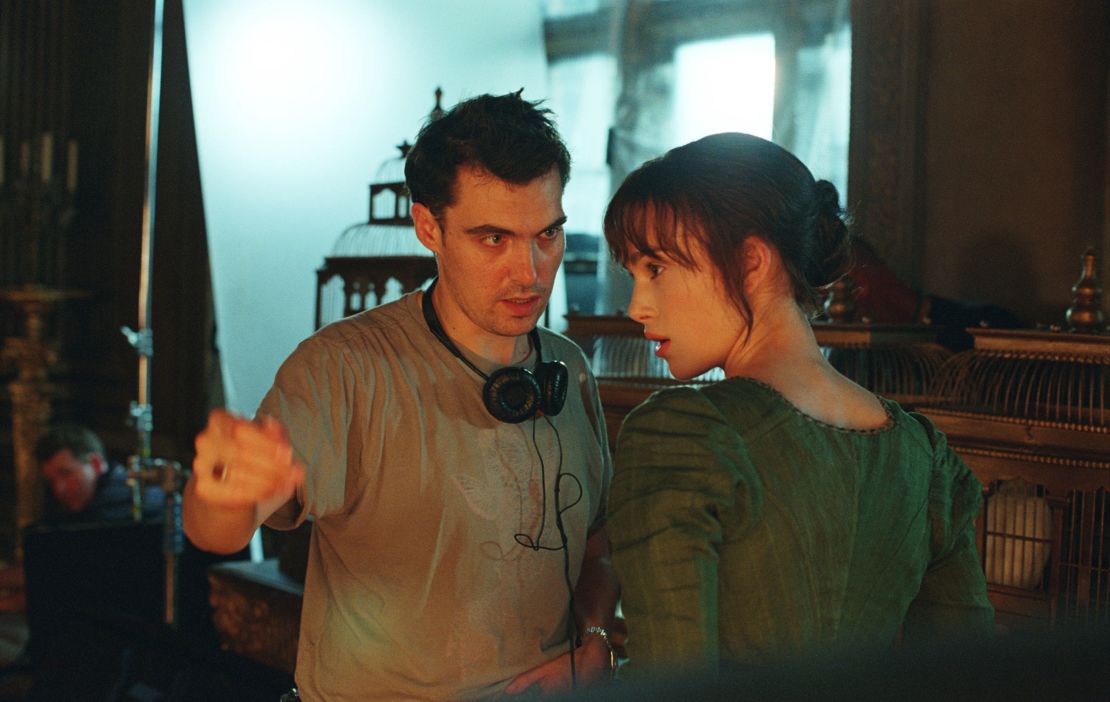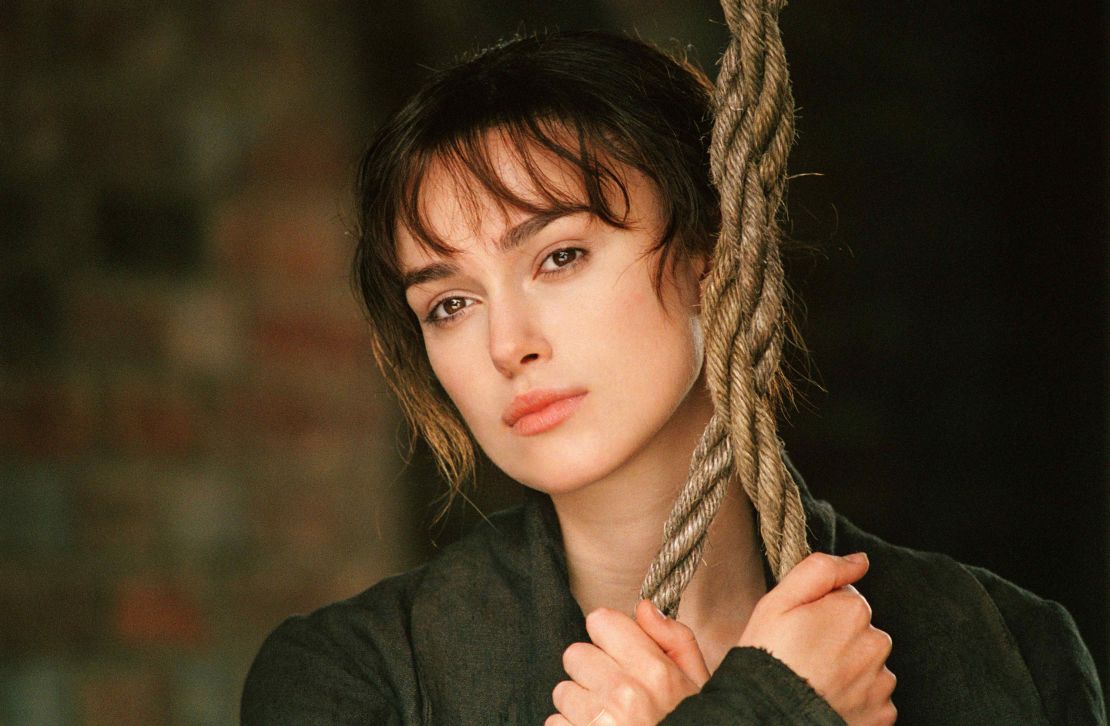Cnn
–
One of the most emblematic scenes of “Pride & Prejudice” (2005) is the first proposal scene.
Even those who have not yet watched the beloved film probably have an idea of the photo. Turd by the rain, Mr. Darcy (Matthew Macfadyen) – The wet hair that is addressed against his forehead – admits his adoration to the courageous protagonist Elizabeth Bennet: “I love you, most ardently.”
Those who know history know what is going on. Elizabeth (Keira Knightley) denies it as well as the two parties, continuing their tense of tense will. But in the original novel by Jane Austen, the scene occurs inside, empty of all regular showers or rolling hills in the background.
And, in the novel, devoid of any index of the real feelings of Mr. Darcy, his proposal is a total shock. But in the version of director Joe Wright, there are clues: breaths, flexions by hand and sexual tensions thick to decide.
These are just a few The elements that distinguish this version of “Pride and Prejudice” from the original novel. And this is one of the reasons why this film has resonated even with those who may not consider themselves fans of Austen.
Wright’s “Pride & Prejudice” is back in theaters this week in honor of his 20th anniversary. So we watched how, exactly, the film continues to delight viewers, body and soul.
While “Pride and Prejudice” has been the subject of many mini-series and modern brand taken, Wright’s film is only considered the second faithful cinematographic adaptation, alongside the 1940 film with Greer Garson and Laurence Olivier.
Until his first 20 years ago, the BBC 1995 mini-series with Colin Firth as Mr. Darcy was considered the most emblematic visual adaptation. Many fans of Austen kiss this version, which, more than five hours, follows the novel more strictly.
But as we can see in the scene of the proposal, the freedoms that Wright takes with the text lends to the call of his adaptation.

While Devoney Looseer, Jane Austen Scholar and author of the next “Wild for Austen”, considers the BBC mini-series of 1995 as its personal favorite adaptation, most of its students prefer the 2005 film, she said. Over the years, she came to see her virtues.
Wright’s approach for Mr. Darcy is one of the main differentiaries. In the original text, and largely in the 1995 version, the character is exposed and thorny. His feelings are largely hidden, hence the reason why this first proposal is such a surprise, said more loose.
Darcy de Macfadyen is different. Although he is still distant, he is more convent and tortured, and the public clearly sees the effect that the presence of Elizabeth has on him. It is misunderstood and aspires, more than it is simply detestable. And that makes him desirable, not only for Elizabeth, but for the public.
Wright is not the first to make the character of Mr. Darcy attractive for viewers; In fact, this idea of an “attractive Darcy” is found in many XXth century adaptations, said Looser. But Wright looks even more at romantic tension. As viewers, we are hooked.
“The public has something to invest emotionally (in),” said Looser. “And, I think in terms of sexual desire in Darcy, visually.”
Note the scene when Elizabeth’s sister Jane (Rosamund Pike) falls ill at Netherfield, where Mr. Darcy and his companions remain temporarily. When Elizabeth Visits, we hear Carolyn Bingley, off screen, which she seems “positively medieval”.
But the camera focuses on Mr. Darcy’s line of view, so we do not see Elizabeth’s muddy dress or her dirty boots. Instead, the camera dwells on her wide eyes and cascading hair – a striking contrast with the lens The book and other adaptations, said Loosers. The public is allowed to take a look at the tense and clumsy feelings that Mr. Darcy holds.
And take the famous hand flexion scene, so well known that the distributors’ development features now sell t-shirts and hooded sweatshirts with the outstretched hand of MacFadadyen. In the scene, Mr. Darcy helps Elizabeth to in his car. As she intervenes, his hand always in his, he releases his palm, moves and walks away, while Elizabeth looks in perplexity. Then he flexes his hand as if he had been shocked – a release of emotional electricity that his touch has worked.
Wright gives us this visual idea of the mind of Darcy and his feelings, said Laber, but Austen does not do so. This tension, built throughout the film, seizes the public attentions and even fills the most commonplace moments of heat.

But Wright’s “Pride & Prejudice” is not only a love story. While many adaptations give an overview of Darcy’s interior life, Wright extends this objective to all the characters in history, said Justin Smith, a film and television history teacher at the University of Montfort in Leicester, in England.
Take Elizabeth’s sister, Mary (Talulah Riley). When Elizabeth announces her rejection From the proposal of Mr. Collins, Wright’s camera focuses on Mary, whose face fills with a melancholic expression.
“It’s almost as if she said:” I would say yes if he asked me, “said Smith,” and a whole story emerges about her. “”
Wright’s small windows help all the characters to come to life, said Smith, in a way that does not occur in other adaptations. Together, they create a rich world for viewers. Beyond the romance, the “pride and prejudices” of Wright could be a family tale, and who cannot relate to a throbbing mother or to the jealousy of brothers?
Today, the film lands differently
When it was released, Wright’s “Pride & Prejudice” was a success, more than $ 121 million worldwide reported with a budget of $ 28 million and a casting by two stars up. The critic Roger Ebert gave the film, which was then nominated for four Oscars, four in four stars. The soundtrack is filled with a piano and a song of birds to bed; The cameras scan lush hills and greenery. Each frame looks like a painting.
But the recovery arrives at a very different moment from the first original in 2005. Cinema cinemas are declining, mourning analysts of films in mid-bu and romantic dramas are not as omnipresent as they were in the past. Although this context may not escape the beauty of the film, the public addresses today with a distinct lens.

People flooded theaters to see the 1940 adaptation, which was produced during the Second World War as part of an effort to stimulate morale, said Deborah Cartmell, English teacher at the University of Montfort and expert in adaptation studies. The public wants to see this nostalgic look at a “merit of fighting” for England.
A similar nostalgia could be at stake today, she said.
“Watching it makes you feel really nostalgic 20 years ago,” said Cartmell. “In these turbulent times, it’s a really reassuring story to look at and appreciate.”
There is also something soothing to look at two people to meet and fall in love, not necessarily in the most magical way, but in a way that seems natural and true. Today, when a large part of the romance is mediated by dating applications and text messages, looking at the face to face can also be nostalgic, said Smith.
“The films remind us of the very tangible and raw nature of emotion and human intimacy, and to get to know someone in physical spaces,” said Smith. “It may seem eccentric, but I think we can have a nostalgia for romance and the courtyard which preceding the rituals and conventions of the digital era.”
Wright’s “Pride & Prejudice” drama recalls this more organic way of meeting someone, knowing them and moving on to love. According to Smith, Smith deserves to be celebrated.




